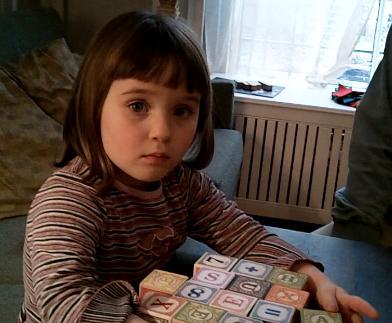Subtraction
 |
Here
are 3 different subtraction problems. Each can be represented by
the equation |
The names of these different problem types are not important - I made them up. (For children it is not even important that they call this "subtraction.") What is important is the fact that your child is going to see all 3 types in school and that the first step in learning to solve such problems is learning to model them in the simplest possible way.
Easy Subtraction
1. What Is The Model For Easy Subtraction?
Here is the easiest way to model the Easy Subtraction problem above:
- Count out 5 objects to represent Trixie's 5 lollipops,
- separate out 3 of those 5 objects to represent the 3 red lollipops and move those 3 objects to the side,
- then count the lollipops that remain.
2. How Do You Teach Easy Subtraction?
I have argued elsewhere that the first step in teaching a child to solve any particular type of word problem is direct instruction. So in the case of Easy Subtraction the child should be presented with simple examples and shown how to make the corresponding Easy Subtraction model. Here is Trixie solving a very simple problem.
Hard Subtraction 1
1. What Is The Model For Hard Subtraction 1?
Here is how to model this problem: Rose has 5 lollipops. Eva has 3 lollipops. Rose has how many more lollipops than Eva?
- Count out 5 objects to represent Rose's 5 lollipops.
- Count out 3 objects to represent Eva's lollipops.
- Match up Eva's 3 lollipops with 3 of Rose's lollipops.
- Count the "extra" lollipops that Rose has.
2. How Do You Teach Hard Subtraction 1?
- In this video Trixie is only 2 years and 11 months old. It is clear that she needs my help with a Hard Subtraction 1 problem.
- Here she is 5 months later. In some ways she seems much more capable. But she still needs help.
Hard Subtraction 2
1. What Is The Model For Hard Subtraction 2?
Here is how to model this problem: Rose has 5 lollipops. Rose has 3 more lollipops than Eva has. How many lollipops does Eva have?
- Count out 5 objects to represent Rose's 5 lollipops.
- Separate out the 3 lollipops that Rose has that are more than the lollipops that Eva has.
- Give Eva some lollipops - enough to match those of Rose that were not separated out.
- Count the lollipops that Eva has.
2. How Do You Teach Hard Subtraction 2?
In this example I help Trixie solve a Hard Subtraction 2 problem. You will see that at 3 years and 4 months she has little understanding of what it is that she is supposed to do.
Summary and Additional Comments
Easy Subtraction, Hard Subtraction 1, and Hard
Subtraction 2 are all
different from one
another. It is important that children see all 3 types. You have seen
above that the
child who knows how to model one type does not necessarily know how to
model the other two.
Click here
to download a printable PDF summary, in a new window, of the models of
the 3 types of subtraction word problems.
Within any one category of subtraction word problems, some examples may
pose more difficulties
than others. Consider these two examples of Easy Subtraction.
Trixie had 5 toy cars. She gave 3 of her cars to Rose. How many toy
cars does Trixie have left?
Trixie's has a ribbon that is 5 feet long. She cut off the first 3 feet
and gave it
to Rose. How many feet of ribbon does Trixie have left?
These two problems are modeled in exactly the same way as one another.
In each case
Trixie has 5 of something and gives 3 of those things away.
Nevertheless, the problems
are different enough from one another that children should have
experiences solving
both.
If you are curious about the relationship between Easy Addition word
problems and Easy
Subtraction word problems, click here.
If you would like to read more about the relationship between Hard
Addition, Hard Subtraction 1, and Hard Subtraction 2, click here.
Finally, some addition word problems sound like they are subtraction
problems. And
some subtraction problems sound like addition problems. To learn more,
click here.
Shortcuts
As with all 10 different types of word problems, once children have mastered any of the subtraction models they will start, largely on their own, to use shortcuts. In these first two examples, Eva and Rose use their own ability to reason. By doing so they are able to avoid making models.
In the two examples above there was little that I needed to do to help. Here, Eva does need some real help, but she does not need me to tell her what to do.